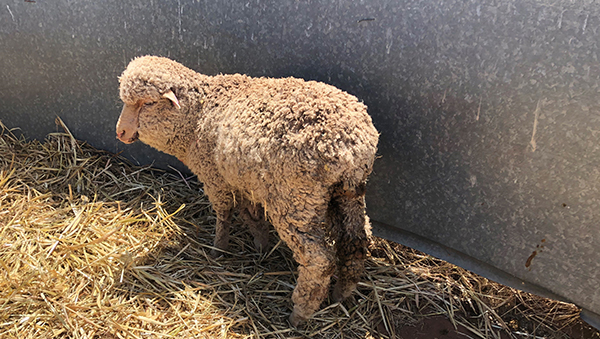CASE STUDY | From flash to flat
01 Jan 2019
Case history:
Riverina producer called to report scouring and deaths in 8–14-week-old first cross lambs.
Lambs were marked 2 weeks prior, where they were ear tagged/marked, tail docked and castrated using elastrator rings and received a 6-in-1 vaccination.
No abnormalities were observed at lamb marking and ewes and lambs were in excellent condition. After marking, ewes and lambs were returned to the same naturalised pasture (notably low in feed) and allowed to recover for a week before being relocated to a fresh pasture.
The producer observed dramatic weight loss and scouring in the lambs at this time. The pasture comprised of native grasses and medics and the flock were supplemented with cereal hay and loose lick supplements.
Deaths started to occur in the lambs ~ 3 days after relocating to the fresh pasture. The mortality rate had risen to 5% by the time the District Veterinarian was called out to investigate.

Clinical examination:
20% of lambs presented with dark green watery diarrhoea with severe dags around the perineum and hocks.
Affected lambs were in poor condition (BCS 2/5) and continuing to deteriorate despite adequate feed being available. On close examination, affected lambs were weak, lethargic, and dehydrated. The occasional ewe also had scours.
Post-mortem examination revealed excess fluid within the abdominal cavity (ascites), typically associated with hypoproteinaemia (low protein). Profuse watery diarrhoea extended throughout the gastrointestinal tract (GIT), and the intestines were thickened and inflamed. The lymph nodes surrounding the GIT were significantly enlarged and active.
Laboratory results:
A culture on the intestinal contents resulted in a profuse growth of Yersinia paratuberculosis. Histopathology on the intestines supported a diagnosis of Yersiniosis and also revealed a moderate scour worm burden. Faecal egg counts on samples collected from the flock revealed an average of 320epg. In clinically affected lambs the FEC was lower at 80epg.
Faecal Samples | Strongyle | Nematodirus | Tapeworm | Coccidia |
Lamb 1 | 80 | 0 | 0 | + |
Lamb 2 | 80 | 0 | 0 | + |
Flock | 320 | 80 | 0 | + |
Diagnosis: Yersiniosis with concurrent nematodiasis (internal parasitism)
What does this mean?
Yersiniosis is a bacterial infection of the gastrointestinal tract caused by the bacteria Yersinia paratuberculosis or enterocolitica.
Yersinia spp. are common inhabitants of sheep intestines with transmission, via the faecal oral route, occurring typically without the development of clinical signs.
Clinical disease occurs more commonly in 3–18-month-old lambs/hoggets and will often precipitate following the onset of cold wet windy weather and an associated stressful event (e.g., lamb marking or weaning).
Typically, yersiniosis only results in low mortality, however concurrent infection with gastrointestinal parasites will result in higher mortality.
When the immune system is overwhelmed bacteria such as Yersinia spp. and parasitesinvade, colonise and damage the wall of the intestine. The immune system reacts to the invasion which results in the swelling and thickening of the intestines and inflammation of the lymph nodes as seen on post mortem. This reduces the intestines’ ability to absorb nutrients resulting in weight loss, low protein, and diarrhoea. In this case, the stress of mustering/yarding and decline in nutrition following lamb marking likely caused an increase in excretion of Yersinia spp. and worms from the ewes, which provided the opportunity for the pathogens to infect and establish in the lambs.
Despite low egg counts, the histopathology on affected lambs revealed a high worm burden. This occurs when lambs are exposed to large worm numbers and they succumb to disease before they have the opportunity to reproduce and cause high egg counts.
What can be done to prevent?
Affected animals should be identified, provided with supportive therapy (fluids, good nutrition) and treated with systemic antibiotics. In the face of an outbreak, steps should be taken to improve the flocks environmental conditions – reducing exposure, improving nutrition, and reducing stress factors. Internal parasite control is important in reducing the susceptibility of sheep to Yersiniosis, therefore drenching may be required in flocks with concurrent internal parasite burden, as was the case in this flock.
For more reading: Yersinia enteritis sheep (flockandherd.net.au)